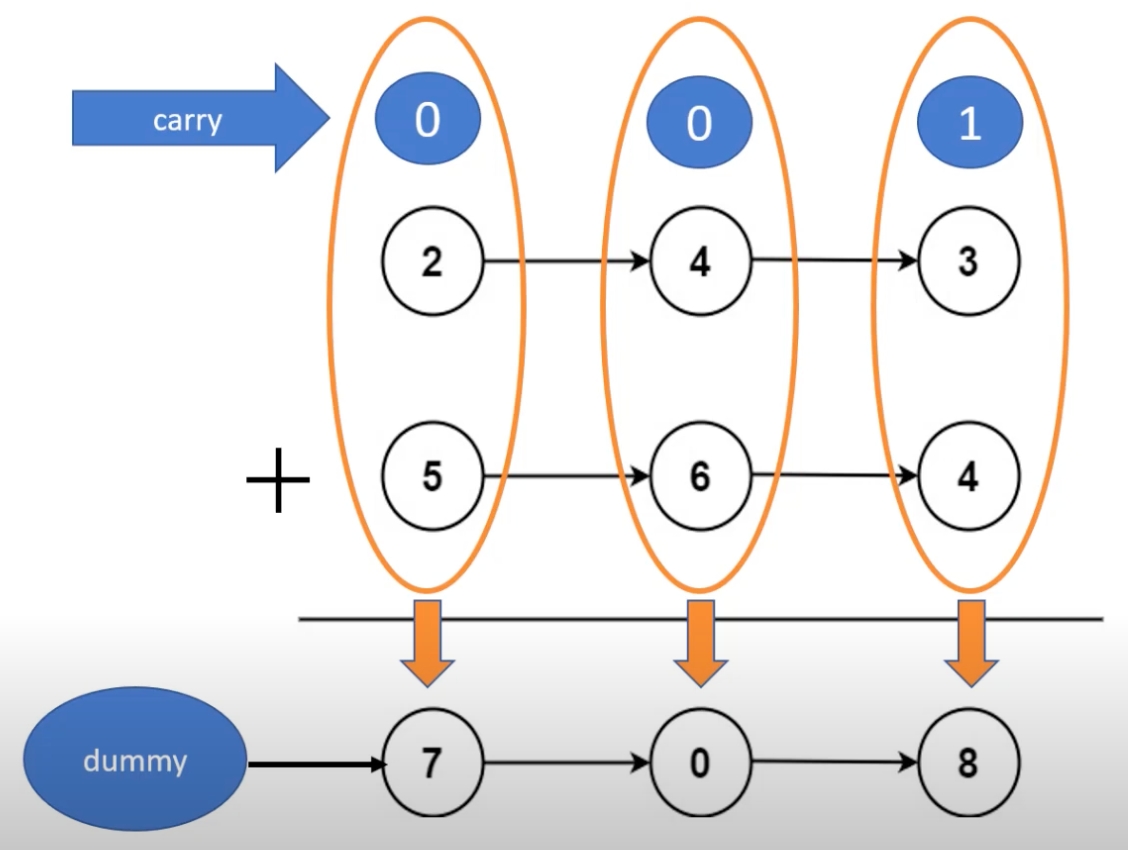Programming

Leetcode-2. Add Two Numbers

You are given two non-empty linked lists representing two non-negative integers. The digits are stored in reverse order, and each of their nodes contains a single digit. Add the two numbers and return the sum as a linked list.
You may assume the two numbers do not contain any leading zero, except the number 0 itself.
Example 1:
Input: l1 = [2,4,3], l2 = [5,6,4]
Output: [7,0,8]
Explanation: 342 + 465 = 807.
Example 2:
Input: l1 = [0], l2 = [0]
Output: [0]
Example 3:
Input: l1 = [9,9,9,9,9,9,9], l2 = [9,9,9,9]
Output: [8,9,9,9,0,0,0,1]
<解題>
- 因為他是把陣列裡的數字反過來儲存後,再相加,所以我們必須要從第一個節點的值開始處理。
- 判斷l1, l2值是否處理完畢(為空)->//l1 != null:表示鏈表 l1 還有數字未處理carry > 0:表示存在進位
- 同時也要用carry值來儲存值,讓下一位數進位與否。

public class Solution {
public ListNode addTwoNumbers(ListNode l1, ListNode l2) {
ListNode temp = new ListNode(0);
ListNode result = temp;
int dummy= 0;
int carry = 0;
while (l1!=null || l2!=null || carry>0){ //l1 != null:表示鏈表 l1 還有數字未處理carry > 0:表示存在進位
if(l1!=null) {
dummy += l1.val;
l1 = l1.next;
}
if (l2!=null){
dummy += l2.val;
l2 = l2.next;
}
dummy += carry;
if (dummy>9){
dummy -= 10;
carry =1; //進位
} else {
carry=0; //沒進位
}
temp.next = new ListNode(dummy);
temp = temp.next;
dummy =0;
}
return result.next;
}
}
Time: O(Max(m,n)) Space: O(Max(m,n))
- m and n are the size of l1 and l2
<補充>
在寫的時候,自己輸入了數字去驗證
public class Main {
public static void main(String[] args) {
ListNode l1 = createLinkedList(new int[] {2,4,3});
ListNode l2 = createLinkedList(new int[] {5,6,4});
Solution solution = new Solution();
ListNode result = solution.addTwoNumbers(l1, l2);
// 輸出結果鏈表
printLinkedList(result);
}
// 輔助方法,將陣列轉換為鏈表
private static ListNode createLinkedList(int[] nums) {
ListNode dummy = new ListNode(0);
ListNode curr = dummy;
for (int num : nums) {
dummy.next = new ListNode(num);
dummy = dummy.next;
}
return curr.next;
}
// 輔助方法,輸出鏈表的值
private static void printLinkedList(ListNode head) {
ListNode curr = head;
while (curr != null) {
System.out.print(curr.val + " ");
curr = curr.next;
}
System.out.println();
}
}
public class ListNode {
int val;
ListNode next;
ListNode prev;
ListNode(int val) {
this.val = val;
}
}
public class Solution {
public ListNode addTwoNumbers(ListNode l1, ListNode l2) {
ListNode temp = new ListNode(0);
ListNode result = temp;
int num1 = 0;
int num2 = 0;
while (l1 != null || l2 != null || num2 > 0) { //l1 != null:表示鏈表 l1 還有數字未處理num2 > 0:表示存在進位
if (l1 != null) {
num1 += l1.val;
l1 = l1.next;
}
if (l2 != null) {
num1 += l2.val;
l2 = l2.next;
}
num1 += num2;
if (num1 > 9) {
num1 -= 10;
num2 = 1; //進位=1
} else {
num2 = 0; //沒進位=0
}
temp.next = new ListNode(num1);
temp = temp.next;
num1 = 0;
}
return result.next;
}
}
<補充>
condition ? expression1 : expression2
-> 這個語法表示如果條件為真,則返回表達式1的結果;否則,返回表達式2的結果
和以下相同:
if (condition)
expression1;
else
expression2;